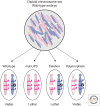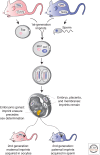Genomic imprinting in mammals
- PMID: 24492710
- PMCID: PMC3941233
- DOI: 10.1101/cshperspect.a018382
Genomic imprinting in mammals
Abstract
Genomic imprinting affects a subset of genes in mammals and results in a monoallelic, parental-specific expression pattern. Most of these genes are located in clusters that are regulated through the use of insulators or long noncoding RNAs (lncRNAs). To distinguish the parental alleles, imprinted genes are epigenetically marked in gametes at imprinting control elements through the use of DNA methylation at the very least. Imprinted gene expression is subsequently conferred through lncRNAs, histone modifications, insulators, and higher-order chromatin structure. Such imprints are maintained after fertilization through these mechanisms despite extensive reprogramming of the mammalian genome. Genomic imprinting is an excellent model for understanding mammalian epigenetic regulation.
Figures








References
-
- Allis CD, Jenuwein T, Reinberg D 2014. Overview and concepts. Cold Spring Harb Perspect Biol 10.1101/cshperspect.a018739 - DOI
-
- Barlow DP 2011. Genomic imprinting: A mammalian epigenetic discovery model. Annu Rev Genet 45: 379–403 - PubMed
-
- Barlow DP, Stoger R, Herrmann BG, Saito K, Schweifer N 1991. The mouse insulin-like growth factor type-2 receptor is imprinted and closely linked to the Tme locus. Nature 349: 84–87 - PubMed
WWW RESOURCES
-
- http://www.mousebook.org/catalog.php?catalog=imprinting. MouseBook, Medical Research Council.
Publication types
MeSH terms
Substances
LinkOut - more resources
Full Text Sources
Other Literature Sources
